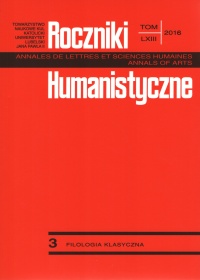Introducing the first topic slot in Plautine dialogues
Abstrakt
Przechodzenie do pierwszego tematu rozmowy w dialogach Plauta
Komediowe dialogi Plauta zdają się posiadać zewnętrzną strukturę zgodną z konwencjami codziennej rozmowy. W niniejszym artykule badane są mechanizmy przechodzenia z (rytualnej) fazy otwierającej do części dialogu zorientowanej na realizację celów konwersacyjnych, w której inicjator kontaktu wyjawia swoją motywację. W pierwszej kolejności pokrótce nakreśla się różnicę między tematem prowizorycznym (small talk) a właściwym pierwszym (niefatycznym) tematem rozmowy. Dalsza analiza Plautyńskiego korpusu ujawnia współwystępowanie różnych mechanizmów przejścia do fazy środkowej dialogu: od wieloturowych sekwencji wypowiedzi po model jednoturowy. Bardziej złożone negocjacje wokół miejsca wprowadzenia pierwszego tematu wydają się typowe dla symetrycznych interakcji między wysokimi postaciami pozostającymi w przyjacielskich relacjach. Bezpośrednie przejścia z kolei pojawiają się w dialogach między panem a niewolnikami lub agresywnymi i farsowymi wymianami między niskimi postaciami. Niektóre cytowane przypadki ponadto sugerują, że na wybór modelu przejścia ad rem mają wpływ także szerszy kontekst spotkania oraz względy dramaturgiczne (charakterystyka postaci, postęp akcji itp.). Wreszcie w artykule przewijają się uwagi dotyczące zjawiska językowej grzeczności, która wydaje się ściśle związana z wyborem stylu wprowadzenia pierwszego tematu.
Bibliografia
Barrios-Lech, Peter. 2014. “Quid Ais and Female Speech in Roman Comedy”. Hermes 142(4): 480–486.
Berger, Łukasz. 2016. Otwarcie dialogowe w komediach Plauta. Poznań: Poznańskie Studia Polonistyczne.
Brown, Penelope and Levinson, Stephen C. 1987. Politeness: Some universals in language usage. Cambridge: Cambridge University Press.
Cheepen, Chrisitine. 2000. “Small talk in service dialogues: The conversational aspects of transactional telephone talk.” In Small talk, edited by J. Coupland, 288–311. Harlow: Longman.
Coulmas, Florian. 1981. “Introduction: Conversational Routine.” In. Conersational Routine. Explorations in Standarized Communication Situations and Prepatterned Speech, edited by Idem, 1–17. The Hague: Walter de Gruyter.
De Melo, Wolfgang (ed.). 2011–2013. Plautus. Comedies. V vols, edited and translated. Cambridge/Massachusetts: Cambridge University Press.
Herman, Vimala. 1995. Dramatic Discourse. Dialogue as Interaction in Plays. London: Routledge 1995.
Hoffmann, Maria E. 1983. “Conversation Openings in the Comedies of Plautus.” In Latin Linguistics and Linguistic Theory, edited by H. Pinkster, 217–226. Amsterdam: J. Benjamins,
Hofmann, Johann B. 1926. Lateinische Umgangssprache, Heidelberg: C. Winter.
Hough, John N. 1945. “The numquid vis formula in Roman comedy.” In The American Journal of Philology 66(3): 282–302.
Kroon, Caroline. 1995. Discourse particles in Latin: a study of nam, enim, autem, vero, and at. Amsterdam: Gieben.
Laver, John. 1981. “Linguistic routines and politeness in greeting and parting.” In Conversational routine, edited by F. Coulmas, 289–304. The Hague: Mouton.
Letessier, Piere. 2000. “La salutation chez Plaute. Adaptation ludique d’un rituel social.” In Lalies 20: 151–163.
Levinson, Stephen, C. 1983. Pragmatics. Cambridge: Cambridge University Press.
Malinowski, Bronisław. 1923. „The Problem of Meaning in Primitive Languages.” In The Meaning of Meaning, edited by Ch. K. Ogden and I. A. Richards, 296–336. London: Kegan Paul.
Moore, Timothy J. 1996. The Theater of Plautus: playing to the audience. Austin: University of Texas Press.
Müller, Roman. 1997. Sprechen und Sprache. Dialoglinguistische Studien zu Terenz. Heidelberg: Universitätsverlag C. Winter.
Poccetti, Paolo. 2010. “Greeting and farewell expressions as evidence for colloquial language: between literary and epigraphical texts.” In Colloquial and Literary Latin, edited by Eleanor Dickey and Anna Chahoud, 100–126. Cambridge: Cambridge Univ. Press.
Roesch, Sophie. 2002. “Les stratégies de clôture du dialogue dans les comédies de Plaute.” In Theory and Description in Latin Linguistics: Selected Papers from the XIth International Colloquium on Latin Linguistics, edited by A.M. Bolkestein et al., 317–332. Amsterdam: Gieben.
Sacks, Harvey. 1975. “Everyone has to lie.” In Sociocultural dimensions of language use, edited by Ben Blount and Mary Sanches, 57–79. New York: Academic Press.
Schegloff, Emanuel A. and Sacks, Harvey. 1973. “Opening up closings.” Semiotica 8(4): 289–327.
Schegloff, Emanuel A. 1968. “Sequencing in Conversational Openings.” American Anthropologist 70(6): 1075–1095.
Schegloff, Emanuel A. 1986. “The routine as achievement.” Human studies 9(2–3): 111–151.
Unceta Gómez, Luis. 2016. “Conceptualization of Linguistic Politeness in Latin: the Emic Perspective”, paper given during the Historical Politeness Symposium, University of East Anglia, June 2016 (in press).
Watts, Richard J. Politeness. Cambridge: Cambridge University Press 2003.
Žegarac, Vlad and Clark, Billy. 1999. “Phatic interpretations and phatic communication”. Journal of Linguistics 35(2): 321–346.
Copyright (c) 2016 Roczniki Humanistyczne

Utwór dostępny jest na licencji Creative Commons Uznanie autorstwa – Użycie niekomercyjne – Bez utworów zależnych 4.0 Międzynarodowe.





